Decor
How Long to Leave Lunar New Year Decorations Up?
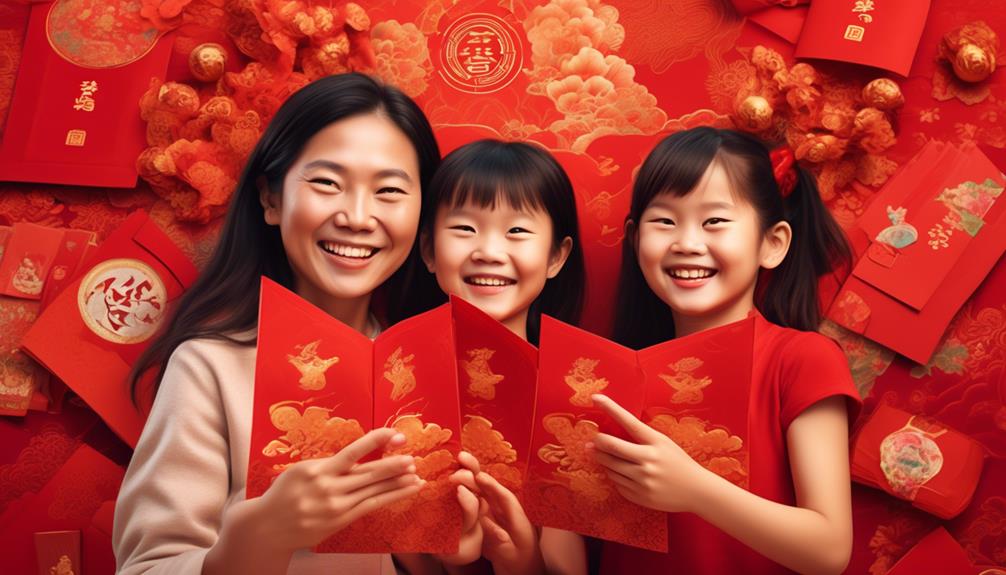
As the Lunar New Year begins, we face the question of the duration to maintain the holiday adornments. In various cultures, these decorative items carry symbolic and cultural value, impacting the timing for their removal.
Understanding the traditional customs and beliefs surrounding Lunar New Year decorations can shed light on the appropriate timing for their removal. This brief guide aims to explore the factors that influence the duration of Lunar New Year decor, offering insights into the auspicious meanings, superstitions, and transitioning to spring decor.
Whether you’re keen on preserving tradition or adapting to change, navigating the timeline for Lunar New Year decorations can be a thoughtful and meaningful process.
Key Takeaways
- Lunar New Year decorations should be taken down within two weeks after the Lunar New Year to preserve their energy and avoid inviting bad luck.
- Removing decorations on the first day of the Lunar New Year is considered unlucky, and sweeping or cleaning during the first few days may sweep away good luck.
- Proper storage of decorations is important, with clean and organized storage methods following Feng Shui principles to ensure the household’s energy flow is not negatively affected.
- Traditional Lunar New Year decorations include red lanterns, couplets, and calligraphy, which hold deep cultural significance and symbolize prosperity, good luck, and happiness.
Cultural Significance of Lunar New Year Decorations
Lunar New Year decorations hold significant cultural importance, symbolizing traditional values and beliefs within the community. These decorations aren’t just mere adornments; they’re a reflection of deep-rooted cultural practices that have been passed down through generations.
The vibrant red lanterns, intricate paper cutouts, and symbolic floral arrangements create a festive atmosphere that’s meant to usher in good luck, prosperity, and happiness for the coming year. Each decoration is carefully chosen to embody auspicious meanings, such as wealth, longevity, and harmony, aligning with the cultural practices observed during the Lunar New Year.
In many communities, the act of adorning homes and public spaces with these decorations is a communal effort, fostering a sense of togetherness and shared cultural identity. The festive atmosphere created by these decorations not only brings joy and excitement but also serves as a visual representation of the values and beliefs that bind the community together.
As we delve deeper into the cultural significance of Lunar New Year decorations, it becomes evident that these adornments aren’t just ornamental, but integral to the preservation and celebration of rich cultural traditions.
Traditional Customs and Beliefs
Embracing time-honored customs and beliefs during the Lunar New Year celebration fosters a deep sense of cultural connection and continuity within our community. Folklore traditions play a significant role in Lunar New Year celebrations, reflecting the rich tapestry of beliefs and practices that have been passed down through generations. From the mesmerizing dragon and lion dances to the symbolic giving of red envelopes, these folklore traditions are steeped in meaning and serve to connect us with our ancestors.
Ancestral customs also hold a special place in our hearts during this auspicious time. Honoring our ancestors through rituals and offerings is a way to express gratitude for their sacrifices and seek blessings for the future. The act of setting up an ancestral altar, lighting incense, and presenting offerings is a solemn yet profoundly meaningful tradition that binds us to our roots.
Understanding and participating in these folklore traditions and ancestral customs not only enrich our cultural experience but also deepen our appreciation for the values and beliefs that have sustained our community for centuries. It’s through these traditions that we find a sense of belonging and carry forward the legacy of our ancestors.
Symbolism of Red Lanterns
Red lanterns hold deep cultural significance in many East Asian traditions. The vibrant red color symbolizes prosperity, good luck, and happiness.
Understanding the symbolism of red lanterns can provide insight into the rich cultural heritage of Lunar New Year celebrations.
Red Lantern Symbolism
Adorning the streets and homes during Lunar New Year, the vibrant red lanterns hold deep cultural symbolism and significance for many Asian communities.
- Red Lantern Craftsmanship
Red lanterns are often meticulously crafted by skilled artisans, using traditional techniques passed down through generations. Each lantern is a masterpiece, showcasing the craftsmanship and attention to detail of the creator.
- Festive Lighting Traditions
The tradition of hanging red lanterns during Lunar New Year symbolizes the hope for a bright and prosperous future. The warm glow of the lanterns illuminates the surroundings, signifying the dispelling of darkness and the arrival of joy and good fortune.
The red lanterns not only serve as decorative elements but also embody the rich cultural heritage and hopes for auspicious beginnings within Asian communities.
Cultural Significance of Red
The vibrant hue of the lanterns holds deep cultural significance within many Asian communities, representing auspicious beginnings and a rich heritage.
In Chinese culture, red symbolizes good fortune, joy, and happiness, making it an integral part of Lunar New Year celebrations. The color red is believed to ward off evil spirits and bring luck and prosperity, which is why it’s prominently featured in decorations such as lanterns, couplets, and clothing during this festive time.
Additionally, red is also associated with love, passion, and vitality in various other Asian cultures, further emphasizing its cultural significance.
The symbolism of red lanterns, in particular, extends beyond the visual appeal, serving as a powerful representation of tradition, unity, and the collective hope for a bright and prosperous future.
Auspicious Meanings of Couplets and Calligraphy
As we explore the auspicious meanings of couplets and calligraphy, we uncover the rich symbolism embedded in these traditional Lunar New Year decorations.
The couplets carry profound messages of luck, prosperity, and happiness, while the artistry of calligraphy reflects the beauty and elegance of Chinese culture.
Understanding the cultural significance behind these decorations adds depth and meaning to the festive atmosphere of the Lunar New Year celebration.
Couplets and Meanings
Incorporating couplets and calligraphy into Lunar New Year decorations brings auspicious meanings and symbolism to the festivities.
Couplets, known as ‘dui lian’ in Chinese, are two poetic lines that are often displayed on doorways to bring good luck and prosperity. These couplets are carefully chosen to convey meaningful symbolism and are often written in beautiful calligraphy, adding to the artistic expressions of the decorations.
The calligraphy itself holds significant cultural value, with each stroke and character carrying deep symbolism. The characters used in the calligraphy often convey blessings such as happiness, wealth, longevity, and good fortune.
The careful selection of words and the artful presentation of calligraphy in the couplets contribute to the overall ambiance of positivity and well-wishes during the Lunar New Year festivities.
Calligraphy Symbolism
After exploring the meaningful symbolism conveyed through couplets and calligraphy in Lunar New Year decorations, it becomes evident that the artful presentation of calligraphy not only adds to the aesthetic beauty but also holds deep cultural significance, with each stroke and character carrying auspicious blessings. Calligraphy techniques play a crucial role in conveying cultural symbolism, with various styles and brush strokes representing different virtues and wishes. Here’s a glimpse at the symbolism conveyed through calligraphy in Lunar New Year decorations:
| Calligraphy Techniques | Cultural Symbolism |
|---|---|
| Regular Script | Harmony and Balance |
| Running Script | Progress and Vitality |
| Seal Script | Authority and Tradition |
| Cursive Script | Fluidity and Flexibility |
These calligraphy techniques showcase the depth of cultural symbolism embedded in Lunar New Year decorations, enriching the festive atmosphere with profound meanings and aspirations.
Cultural Significance
The cultural significance of Lunar New Year decorations is exemplified through the auspicious meanings conveyed by the couplets and calligraphy, enriching the celebration with profound symbolism and aspirations.
- Festive Atmosphere:
The vibrant red color and intricate designs of the couplets and calligraphy create a lively and joyous ambiance, fostering a sense of excitement and anticipation during the Lunar New Year festivities. The rhythmic flow of the calligraphy strokes and the poetic elegance of the couplets infuse the surroundings with a festive spirit, elevating the overall mood of the celebration.
- Cultural Heritage:
Couplets and calligraphy have been integral parts of Lunar New Year traditions for centuries, embodying the rich cultural heritage and time-honored customs of the festive season. They serve as tangible expressions of cultural identity and values, keeping alive the legacy of artistic expression and traditional beliefs passed down through generations.
Superstitions and Taboos
Many families observe various superstitions and taboos around Lunar New Year decorations, which can influence how long they choose to leave them up.
Superstitions and beliefs play a significant role in the customs and practices surrounding Lunar New Year. Some families believe that taking down decorations too early may result in cutting off good luck or prosperity for the coming year. On the other hand, leaving decorations up too long could be seen as inviting bad luck or stagnant energy into the home.
Taboos also play a part in the timing of removing Lunar New Year decorations. For example, it’s considered unlucky to take down decorations on the first day of the Lunar New Year as it may symbolize sweeping away good fortune. Additionally, certain superstitions caution against sweeping or cleaning during the first few days of the new year to avoid sweeping away good luck.
Understanding these superstitions and taboos can provide insight into the cultural significance of Lunar New Year decorations and the practices surrounding them. It adds depth to the appreciation of the customs and traditions that have been passed down through generations.
Feng Shui Considerations
Considering the cultural significance of Lunar New Year decorations and the beliefs surrounding their timing, we find ourselves drawn to the Feng Shui considerations that influence the placement and removal of these symbolic adornments. In Feng Shui, the timing of Lunar New Year decorations is crucial as it directly impacts the flow of energy, or qi, within the home.
When it comes to the placement and removal of these decorations, several Feng Shui principles come into play:
- Timing of Placement and Removal
- According to Feng Shui principles, it’s advisable to remove Lunar New Year decorations within two weeks after the Lunar New Year to prevent stagnant energy from accumulating in the home.
- Storage Tips
- Proper storage of Lunar New Year decorations is essential. When removing the decorations, it’s recommended to store them in a clean and organized manner. This ensures that the energy they hold is preserved and can be reused in the following year without any negative effects on the household’s energy flow.
Personal Preferences and Timing
From personal experience, I’ve found that the timing for taking down Lunar New Year decorations often varies depending on individual preferences and family traditions.
Some people prefer to leave the decorations up until the Lantern Festival, which marks the official end of the Lunar New Year celebrations.
Others may take them down shortly after the New Year as they transition into the spring season. Timing preferences often reflect personal beliefs and the significance of the Lunar New Year in one’s life.
For some, the decorations hold deep cultural and symbolic meanings, and they prefer to keep them up for an extended period to maintain a connection to their heritage.
On the other hand, some individuals may view the Lunar New Year decorations as specific to the holiday period and prefer to transition into a different set of decor that aligns with the changing seasons. This shift in decor changes can symbolize a fresh start and the arrival of spring.
Ultimately, the decision of when to take down Lunar New Year decorations is deeply personal and varies from family to family, reflecting the diversity of beliefs and traditions within the community.
Community Practices and Events
As we embrace the diverse traditions and personal preferences surrounding Lunar New Year decorations, let’s now shift our focus to the rich tapestry of community practices and events that contribute to the vibrant tapestry of this cultural celebration.
- Community Gatherings
- Lunar New Year brings communities together in joyous celebrations, fostering a sense of unity and cultural pride. Festive events such as parades, dragon dances, and traditional performances create a lively atmosphere, allowing people to share in the excitement and connect with their heritage.
- Symbolism in Decorations and Cultural Practices
- Community events often showcase the deep symbolism behind Lunar New Year decorations. From the vibrant red lanterns symbolizing good fortune to the intricate paper-cuttings representing prosperity, each ornament carries profound cultural significance. These events provide an opportunity for people to deepen their understanding of the customs and rituals associated with the Lunar New Year, fostering a sense of appreciation for the rich heritage they’re part of.
Community gatherings and festive events play a pivotal role in preserving and passing down cultural practices, ensuring that the spirit of Lunar New Year remains vibrant and cherished within our communities.
Transitioning to Spring Decor
As we embrace the transition to spring, many of us may find ourselves contemplating the shift in our home decor.
The change from Lunar New Year decorations to spring-themed embellishments can be a refreshing way to welcome the new season.
Traditional practices and modern influences, as well as the application of Feng Shui principles, all play a significant role in this shift, and it’s fascinating to explore how these factors intertwine to create harmonious and inviting spaces.
Seasonal Decor Change
As we shift from the chilly days of winter to the vibrant days of spring, it’s time to consider the transition of seasonal decor to embrace the fresh, lively spirit of the new season.
- Balancing Act: When transitioning seasonal decor, it’s essential to strike a balance between gradually introducing spring elements and preserving the coziness of the home during the lingering cold spells.
- Incorporate Nature: Introduce elements like fresh flowers, potted plants, and nature-inspired artwork to infuse the space with the rejuvenating essence of spring.
- Lighter Textiles: Swap out heavy winter curtains and throws for lighter, breezier fabrics to create an airy atmosphere, while still ensuring comfort during transitional weather.
Transitioning our home decor with the changing seasons allows us to celebrate the beauty of nature and adapt to the evolving energy of each time of year.
Traditional Vs Modern
Shifting from the cozy ambiance of winter decor to the vibrant allure of spring, we find ourselves evaluating the choice between embracing traditional elements or opting for a more modern approach in our home decor.
When considering traditional versus modern interpretations, it’s essential to respect cultural customs while also embracing contemporary design elements. Integrating traditional symbols like cherry blossoms or auspicious colors can honor heritage while infusing modern flair through sleek lines or minimalist arrangements.
It’s about finding a harmonious balance between preserving cultural significance and embracing innovation. As we transition to spring decor, we can draw inspiration from both the past and present, creating a space that reflects our heritage while resonating with a modern audience.
Feng Shui Principles
Embracing the principles of Feng Shui as we transition to spring decor allows us to harmonize our living space with the energy of the new season. When incorporating Feng Shui into our decorating process, it’s essential to consider the following basics:
- Energy Flow: Arrange furniture to facilitate the flow of positive energy, or chi, throughout the space. Avoid clutter that disrupts the natural flow of energy.
- *Decorating Tip*: Introduce plants and fresh flowers to bring life and vitality into your home, symbolizing growth and renewal as spring approaches.
- Balance and Harmony: Create a sense of equilibrium by using a balanced mix of colors, textures, and shapes. This promotes a feeling of tranquility and well-being within the home.
- *Decorating Tip*: Consider incorporating natural materials like wood and stone to evoke a sense of grounding and connection to nature, enhancing the overall balance in your living space.
Storage Tips for Lunar New Year Decorations
After celebrating Lunar New Year, it’s important to properly store the decorations to ensure they remain in good condition for the following year. Organizational tips and preservation techniques are essential for maintaining the festive allure of Lunar New Year decorations. Here are some insightful storage tips for your Lunar New Year decor:
Organizational Tips Decorative Themes Categorize decorations according to type (lanterns, couplets, figurines) Consider traditional themes such as prosperity, good fortune, and longevity Use clear storage containers to easily identify contents Incorporate zodiac animal motifs for a personalized touch Label each container with its contents for easy retrieval Integrate auspicious colors like red, gold, and pink for a vibrant display Store delicate items separately to prevent damage Opt for decorative pieces that represent spring and renewal Keep a detailed inventory of your decorations for future reference Embrace nature-inspired elements like blooming flowers and flourishing trees
These festive storage tips will help maintain the charm and vibrancy of your Lunar New Year decorations for years to come.
Repurposing Decorative Items
As we consider the longevity of our Lunar New Year decorations, repurposing these festive items offers a creative way to extend their beauty and significance beyond the traditional celebration. Here are some repurposing ideas and DIY projects to give a new life to your Lunar New Year decorations:
- Repurposing Ideas:
- *Lanterns*: Turn decorative lanterns into charming outdoor lighting for your patio or garden by adding LED lights inside. This will create a magical ambiance for evening gatherings.
- *Red Envelopes*: Use leftover red envelopes to create unique greeting cards for birthdays or other special occasions. The vibrant colors and intricate designs will add a touch of elegance to your personalized cards.
- DIY Projects:
- *Paper Cutouts*: Transform paper cutouts into a stunning collage or framed artwork to adorn your home throughout the year. This can be a meaningful way to preserve the intricate craftsmanship of Lunar New Year decorations.
- *Festive Fabrics*: Repurpose festive fabrics, such as traditional Chinese fabrics or decorative cloths, into stylish table runners or cushion covers. This will infuse your living space with a touch of cultural charm beyond the holiday season.
Repurposing decorative items not only reduces waste but also allows you to continue enjoying the beauty and cultural significance of Lunar New Year decorations in new and innovative ways.
Embracing the New Year’s Changes
The changes ushered in by the New Year invite us to adapt and grow, embracing the opportunities for renewal and progress. Embracing change is a fundamental aspect of the lunar New Year, a time when we reflect on the past and look forward to new beginnings.
It’s a chance to embrace change, not just in our homes with the decorations, but in our lives as well. As we pack away the festive ornaments, let’s also take a moment to consider what changes we can embrace in our personal and professional lives.
Perhaps it’s time to start that project we’ve been putting off, or to mend a relationship that needs attention. This period of transition and renewal offers us the chance to step into new beginnings, to shed old habits, and to welcome new opportunities.
Let’s use this time to set intentions for growth and progress, allowing the energy of the New Year to guide us in embracing change and pursuing our dreams.
Frequently Asked Questions
Can I Leave Lunar New Year Decorations up All Year Round?
We can leave Lunar New Year decorations up all year round if we want to. They bring decorative longevity and hold cultural significance.
They infuse our space with year-round symbolism, creating a festive ambiance.
However, it’s important to be respectful of the traditions and meanings behind the decorations. Understanding their cultural significance can deepen our appreciation for them and enhance the atmosphere they create in our homes.
Is There a Specific Date to Take Down Lunar New Year Decorations?
We take down Lunar New Year decorations based on cultural significance and symbolic meaning. It’s important to respect traditions and honor the festival’s rituals.
Superstitions and feng shui also play a role in determining the appropriate time for removal.
Understanding the deeper meanings behind these decorations enriches our experience and fosters a deeper connection to the traditions. It’s a beautiful way to celebrate and preserve our heritage.
What if I Want to Mix Lunar New Year Decorations With Other Seasonal Decor?
We believe that blending Lunar New Year decorations with other seasonal decor can be a beautiful way to honor traditions while embracing the changing seasons.
It’s a lovely way to celebrate new beginnings and the cyclical nature of life.
By mixing decorations, we can create a harmonious space that reflects our respect for various cultures and the passage of time.
It’s a thoughtful and inclusive approach to home decor.
Are There Any Specific Rituals or Ceremonies for Taking Down Lunar New Year Decorations?
In our tradition, taking down Lunar New Year decorations holds symbolic meaning and historical significance.
It’s a time to reflect on the past year’s blessings and prepare for new opportunities.
As for specific rituals or ceremonies, some families might incorporate prayers or offerings to honor their ancestors and seek blessings for the year ahead.
It’s a time of reverence and gratitude, marking a transition from one phase to the next.
What Should I Do With Lunar New Year Decorations That Are Damaged or No Longer Needed?
When it comes to repairing decorations or recycling materials from Lunar New Year decorations that are damaged or no longer needed, we can consider various options.
For damaged items, we can try to mend them using craft supplies or seek out local artisans skilled in restoration.
As for the materials that can’t be repaired, we can explore eco-friendly ways to recycle them, such as repurposing them into new crafts or finding recycling facilities in our community.
Can Lunar New Year Decorations Be Left Outdoors?
Leaving outdoor pillows outside can be a risk for Lunar New Year decorations. Harsh weather conditions might damage delicate items like paper lanterns or silk banners. However, sturdier decorations like plastic figurines or ceramic dishes can withstand outdoor exposure if properly secured.
Conclusion
As we transition from the Lunar New Year celebrations to the arrival of spring, it’s important to respect the cultural significance of the decorations. Whether it’s the auspicious red lanterns or the traditional couplets, each item holds a special meaning.
As we carefully store or repurpose these decorations, let’s embrace the changes that come with the new year and look forward to the opportunities and blessings it brings. After all, change is the only constant in life.
- About the Author
- Latest Posts
Introducing Ron, the home decor aficionado at ByRetreat, whose passion for creating beautiful and inviting spaces is at the heart of his work. With his deep knowledge of home decor and his innate sense of style, Ron brings a wealth of expertise and a keen eye for detail to the ByRetreat team.
Ron’s love for home decor goes beyond aesthetics; he understands that our surroundings play a significant role in our overall well-being and productivity. With this in mind, Ron is dedicated to transforming remote workspaces into havens of comfort, functionality, and beauty.
Southeast Asia Decor
Are Popular Furniture Layouts Really Beneficial?
Discover how popular furniture layouts can transform your space and elevate your style—could they be the key to your home’s potential?

Popular furniture layouts can greatly enhance your space. They boost both functionality and aesthetic appeal, creating a more inviting atmosphere. Using layouts like classic sofa arrangements fosters conversation and social interaction. You'll find that thoughtful placement optimizes flow, making navigation easier. Plus, zoning techniques with rugs help define areas in open spaces, maintaining organization. Keeping clear walkways guarantees everyone moves comfortably, while balancing colors and textures elevates style. Ultimately, adopting these layouts doesn't just enhance comfort but also reflects your personal taste. Keep exploring to uncover more insights on crafting your perfect space.
Key Takeaways
- Popular furniture layouts enhance both aesthetic appeal and functionality, creating inviting and organized spaces.
- Effective arrangements promote social interaction, fostering conversation and connection among occupants.
- Well-planned layouts optimize flow and accessibility, ensuring comfortable navigation throughout the room.
- Zoning techniques using area rugs help define functional areas, adding warmth and style to open spaces.
- Personalized layouts reflect individual style while maximizing space utility and promoting comfort.
Benefits of Popular Layouts

When it comes to furniture layouts, the benefits of popular arrangements are clear. These layouts not only enhance the aesthetic appeal of your space but also improve its functionality.
For example, a classic setup with a sofa and a pair of chairs fosters conversation, making your seating area more inviting and adaptable to various room sizes. Incorporating elements like Indonesian decorative pillows can add vibrant colors and intricate patterns that reflect cultural heritage and enhance comfort.
If you're looking for a more formal vibe, arranging two sofas facing each other creates a symmetrical seating area, perfect for socializing. Angled chairs across from a sofa add visual interest and flexibility, especially in rooms with multiple entrances or features like a fireplace.
Additionally, using rugs can help you create zones within open spaces, giving your area a sense of organization without overcrowding.
Efficient layouts, such as placing chairs flanking a sofa, maximize seating capacity in smaller or narrow rooms while ensuring clear walkways for easy movement.
Enhancing Room Functionality

When you think about enhancing room functionality, effective space planning is key. Arranging your furniture thoughtfully can optimize flow and accessibility, making daily activities easier.
Incorporating elements from Balinese design characteristics can further enhance your space, promoting a connection to nature and creating a calming atmosphere.
With the right layout, you can create inviting spaces that support both social interaction and comfort.
Space Planning Importance
Effective space planning is essential for enhancing room functionality, as it guarantees that every piece of furniture serves a purpose in your living environment. The right furniture placement assures that your living room layout supports activities like relaxation, conversation, or entertainment.
Incorporating unique decor elements, such as Indonesian decor masks, can add vibrancy and cultural significance to your space. When you consider traffic flow, you create a space that feels inviting and accessible.
Before you make any purchases, take the time to visualize your floor plan. This step can help you identify the most efficient layout specific to your room's dimensions and design elements. Remember, not all layouts fit every living room; adaptability is key.
Measuring your space beforehand can prevent sizing issues, allowing you to avoid overcrowding while assuring that each piece fits comfortably.
Using tools like the Homestyler app can elevate your planning process. This user-friendly software lets you experiment with different layouts and design ideas, enhancing the overall functionality of your living area.
Effective Furniture Arrangement
Furniture arrangement plays an essential role in enhancing the functionality of any room. By effectively planning your layout, you can optimize flow and accessibility, ensuring smooth movement throughout the space.
Think about how you navigate your room—consider the "three-foot rule" around your furniture to prevent collisions and create a user-friendly environment. Additionally, incorporating natural materials and colors, such as those found in traditional Indonesian style home decor, can further enhance the ambiance and harmony of the space.
Utilizing versatile layouts, like pairing a sofa with accent chairs, can foster conversation and highlight focal points, such as a fireplace or TV. This approach not only makes the space more inviting but also improves its practicality.
To further define areas within an open space, incorporate rugs as zoning tools. They visually separate different functions without overwhelming the room with additional furniture.
Regularly reassessing your furniture placement allows for continuous improvements. You might find that shifting a chair or reorienting a table can greatly enhance both the aesthetic and functional use of your living area.
Ultimately, effective furniture arrangement transforms your space, making it more organized and enjoyable to navigate, ensuring that every piece serves a purpose.
Promoting Social Interaction
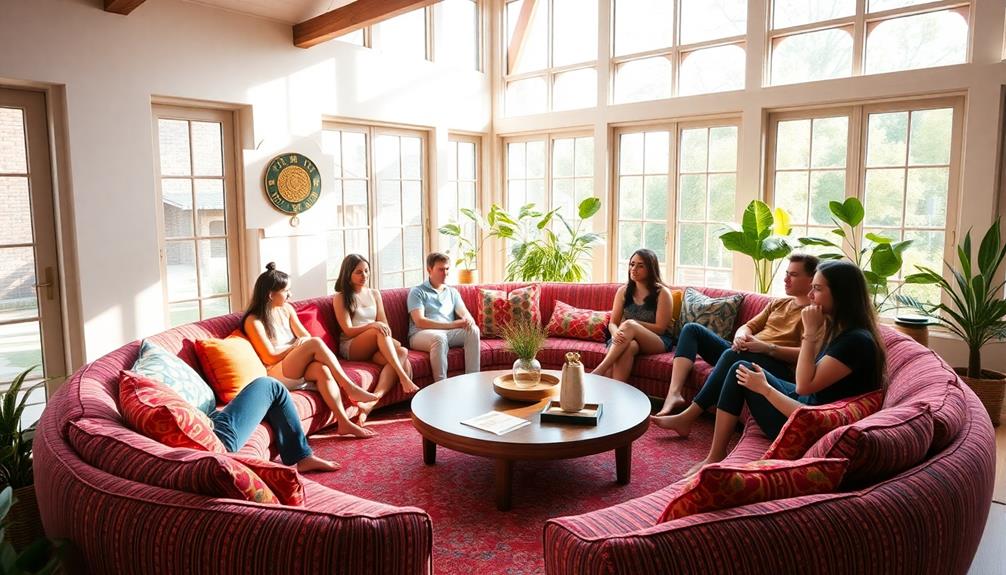
Often, the way you arrange seating can greatly enhance social interaction in your space. By opting for a circular or semi-circular seating arrangement, like positioning two sofas facing each other, you create an intimate atmosphere that encourages conversation.
Incorporating unique pieces from local artisans can also enhance the aesthetic appeal of these arrangements, making them more inviting. Adding accent chairs alongside your sofa not only diversifies your seating but also facilitates dialogue among guests while allowing for activities like watching TV.
Consider placing angled chairs across from a sofa. This setup not only adds visual interest but also promotes easy eye contact, which is essential for effective communication. Aim for a balanced layout that avoids overcrowding; leaving about three feet of walking space around seating promotes comfort and openness.
This setup invites guests to engage more freely. To further define conversation zones within larger areas, utilize area rugs. They visually group your seating arrangements, making it easier for people to gather and interact.
Optimizing Space in Small Rooms

When you're working with a small room, efficient furniture arrangement is key to making the most of your space.
Incorporating personalized design consultations can help in identifying the best layout for your needs.
Consider multi-functional design solutions, like a storage ottoman or a sofa bed, to enhance utility without sacrificing style.
With the right layout, you can create a cozy, inviting atmosphere that feels spacious and functional.
Efficient Furniture Arrangement
Maximizing space in small rooms requires a thoughtful approach to furniture arrangement that balances comfort and functionality. Start by using a single sofa as your focal point. This allows for flexible arrangements while maximizing seating without crowding the area.
Position accent chairs nearby to encourage conversation, promoting social interaction while maintaining an open flow essential for smaller spaces. Incorporating unique decor elements, such as Indonesian decor masks, can enhance the cultural richness of your space while also serving as striking conversation starters.
To further optimize your layout, use area rugs to define different zones within the room. This not only creates visual interest but also helps delineate spaces without adding bulk.
Consider incorporating floating furniture by pulling your sofa away from the walls by about 12 inches. This technique creates a more inviting atmosphere and prevents the cramped feeling that often plagues small rooms.
Additionally, think about multi-functional options, such as ottomans with built-in storage, to enhance usability. These pieces can help keep your space organized and clutter-free, allowing you to enjoy your small room to its fullest.
Multi-Functional Design Solutions
In small rooms, embracing multi-functional design solutions can transform limited space into a highly usable environment. By incorporating multi-functional furniture, like sofa beds or ottomans with storage, you can gain additional functionality without sacrificing valuable floor space. This approach enhances the efficient use of space, allowing you to adapt your room to your needs.
Additionally, the integration of eco-friendly materials in furniture design reflects a growing trend toward sustainability in modern living spaces, echoing the principles found in traditional Indonesian housing.
Utilizing vertical space is also essential. Installing shelving units or wall-mounted storage keeps the floor clear, creating an illusion of a larger area while maximizing storage capacity. Choosing furniture that serves multiple purposes, such as a coffee table that doubles as a workspace, guarantees you're making the most of your limited square footage.
Incorporating sliding or foldable furniture, like drop-leaf tables or collapsible chairs, enables quick adaptations for various activities, making small spaces more versatile.
Additionally, using strategic area rugs can help define different areas within your small room, enhancing organization and allowing for flexible layouts. By thoughtfully selecting and arranging your furnishings, you can create an efficient and functional environment that meets your lifestyle needs.
Visual Balance and Aesthetics

Achieving visual balance in a room involves distributing furniture evenly, so no area feels overcrowded or neglected. When you think about your layout, consider how each piece contributes to the overall aesthetics.
A cohesive color palette among furniture pieces enhances the room's appeal, creating a harmonious atmosphere that invites you in. Additionally, incorporating elements inspired by Indonesian wedding decor ideas can further improve the visual balance through the use of vibrant colors and intricate patterns.
Here are three key elements to focus on for visual balance:
- Accent Chairs: These can introduce texture or pattern, adding visual interest while keeping the balance intact. Choose designs that complement your existing furniture to maintain cohesion.
- Coffee Table: Verify its design complements other furniture styles. A well-chosen coffee table reinforces the room's aesthetic without overwhelming the space.
- Lighting Fixtures: Strategically placed lighting enhances the room's ambiance. Use fixtures to highlight focal points, contributing greatly to the overall visual appeal.
Common Mistakes to Avoid

When arranging your furniture, it's easy to overlook essential elements like walkway space, which can make traversing your room a hassle.
Incorporating outdoor living areas and ensuring a fluid connection between spaces can greatly enhance functionality.
You might also find yourself overcrowding the space or not defining zones effectively, leaving your layout feeling chaotic.
Avoiding these common mistakes will help you create a more functional and inviting environment.
Ignoring Walkway Space
Overlooking walkway space can throw off the entire flow of a room, leading to frustration and discomfort.
When you ignore proper spacing, your living area can quickly become cramped, making it feel smaller and less inviting.
To create a more functional and pleasant environment, consider these essential tips for maintaining walkways around your furniture:
- Maintain Three Feet of Space: Keep at least three feet of walking space around furniture to prevent collisions and guarantee easy navigation.
- Create Clear Pathways: Aim for a clear pathway of 16 to 18 inches between the sofa and coffee table. This promotes ease of movement and enhances the functionality of your open floor plan.
- Regularly Assess Layouts: Periodically evaluate and adjust your furniture placement. This helps maintain open walkways, improving both comfort and usability in the room.
Overcrowding With Furniture
One common mistake many people make is overcrowding their living rooms with too much furniture, which can severely disrupt the flow and functionality of the space. To create a comfortable environment, it's essential to maintain a three-foot walking space around furniture to allow for smooth navigation. If you push all your furniture against the walls, you may end up with a disjointed feel. Instead, consider using floating furniture to foster a cozy, inviting atmosphere.
Here's a quick overview of what to avoid:
| Mistake | Consequence | Solution |
|---|---|---|
| Overcrowding a living room | Difficult navigation and discomfort | Maintain open spaces |
| Ignoring the three-foot rule | Blocked pathways and furniture access | Keep ample clearance |
| Using bulky furniture | Cluttered and cramped feel | Choose appropriate sizes |
Lack of Defined Zones
Failing to define distinct zones in an open-plan layout can make the space feel chaotic and disorganized.
This lack of defined zones can obscure the purpose of each area, making it hard for you and your guests to identify functional areas. Overcrowding furniture in these spaces disrupts movement flow and diminishes usability.
To enhance your layout and avoid common mistakes, consider these tips:
- Use Area Rugs: Area rugs can visually separate different zones, helping maintain organization and purpose in your design.
- Create Central Voids: Be mindful of central voids; they can hinder conversation and social engagement. Guarantee seating arrangements encourage interaction.
- Establish Clear Functions: Assign specific functions to each zone, like a reading nook or a dining area, to give your space character and direction.
Essential Layout Strategies

Creating an inviting space starts with thoughtful furniture layouts that enhance both functionality and comfort. To foster conversation and connection, arrange your sofa alongside a pair of chairs, encouraging social interaction. This simple furniture arrangement helps create a welcoming atmosphere in your living room.
It's also essential to maintain clear walkways, ideally three feet wide, to guarantee comfortable navigation. This prevents collisions with furniture or walls, making your space more user-friendly.
Consider floating your furniture by pulling sofas away from walls. This technique maximizes usable floor space while adding coziness to the room.
Strategically using area rugs can further enhance your layout. They help visually segment different zones within a room, providing organization while elevating the overall aesthetic.
Zoning Techniques for Open Spaces

Open spaces can feel overwhelming, but zoning techniques can transform them into inviting, functional areas.
By effectively dividing your large living room, you create dedicated spaces that offer both purpose and breathing room.
Here are three effective zoning techniques to take into account:
- Area Rugs: Use rugs to visually separate different zones within your open space. A well-placed rug not only defines areas but also adds warmth and style.
- Consistent Styles: Choose rugs with similar styles or colors throughout the space. This unifies the design while still providing clear distinctions between functional areas.
- Strategic Furniture Placement: Position your furniture on the rugs to enhance cohesion. This creates 'rooms within rooms,' giving each area its own identity while maintaining an organized layout.
Importance of Flow and Movement

When designing your furniture layout, the flow and movement within a space play an essential role in its functionality. Prioritizing clear pathways is vital, as you should aim for at least three feet of walking space around furniture. This guarantees comfortable navigation and prevents blocked pathways that can disrupt the flow of movement in a room.
To enhance usability and accessibility, observe your daily routines to identify key routes. By doing this, you can make informed decisions about furniture placement, creating a layout that accommodates how you naturally move through the space. Maintaining open walkways not only improves the perception of spaciousness but also fosters an environment where you can move freely without obstacles.
Regularly evaluating the flow of movement in your room allows for continuous adjustments that optimize comfort and efficiency. As your needs change, revisit your layout to confirm it remains functional.
Adapting Layouts to Personal Style
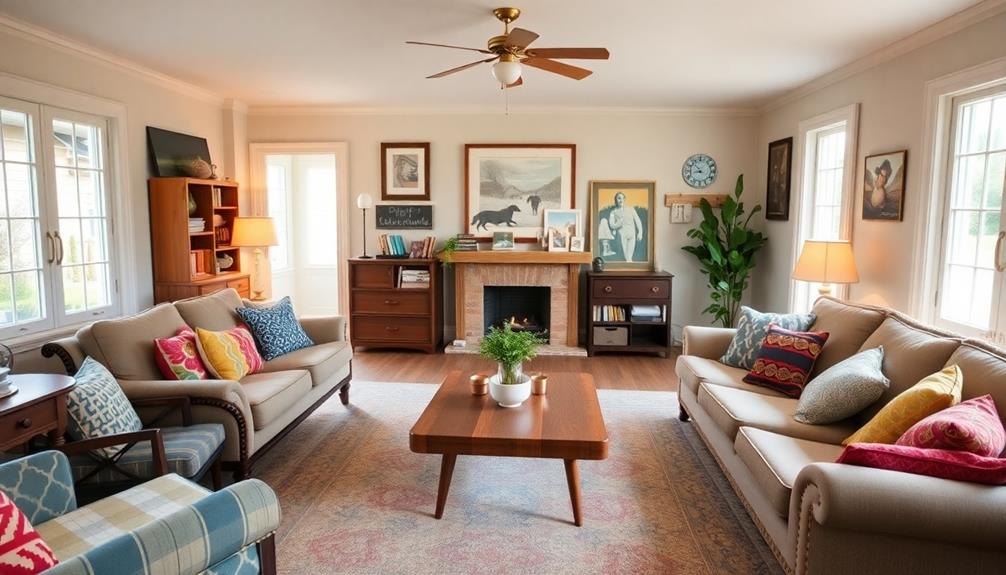
Your furniture layout should reflect your personal style, as this not only enhances the aesthetics of your space but also boosts your comfort and satisfaction.
When you adapt popular furniture layouts to fit your unique tastes, you create a cohesive environment that feels welcoming and tailored just for you.
Here are three ways to achieve that:
- Mix Styles: Combine modern and vintage pieces to create an eclectic yet functional arrangement that showcases your personality.
- Use Color and Patterns: Incorporate bold colors or distinctive patterns in your furniture and decor to make your space vibrant and engaging while maintaining functionality.
- Prioritize Comfort: Guarantee that your layout not only looks good but also promotes comfort and ease of movement, making it a true reflection of your lifestyle.
Frequently Asked Questions
What Is the 2/3 Rule Sofa?
The 2/3 Rule for sofas suggests your sofa should cover about two-thirds of the wall length it faces. This creates balance, guarantees adequate space for other furniture, and improves the room's overall flow and aesthetics.
How to Figure Out the Best Furniture Layout?
To find the best furniture layout, think of your space as a stage. Measure dimensions, visualize with apps, focus on functions, and consider focal points. Adjust regularly to suit your evolving needs and lifestyle.
Is It Better to Have Matching Furniture?
Having matching furniture can create a unified look, but it's not the only option. Mixing styles and textures adds character and depth. Consider your personal taste and the room's function to find the best balance.
Should You Put Your Couch Against the Wall?
You shouldn't always put your couch against the wall. Floating it creates a cozy atmosphere and improves flow. Consider your room's size and layout to foster intimacy and functionality, enhancing your overall living space.
Conclusion
Incorporating popular furniture layouts can transform your space into a functional, inviting haven. By enhancing room functionality, promoting social interaction, and optimizing small areas, you create a home that feels just right. Embrace zoning techniques to define spaces, maintain flow for easy movement, and adapt layouts to reflect your personal style. So, whether you're entertaining friends or enjoying quiet moments, remember that the right layout not only serves your needs but also elevates your living experience.
- About the Author
- Latest Posts
Introducing Ron, the home decor aficionado at ByRetreat, whose passion for creating beautiful and inviting spaces is at the heart of his work. With his deep knowledge of home decor and his innate sense of style, Ron brings a wealth of expertise and a keen eye for detail to the ByRetreat team.
Ron’s love for home decor goes beyond aesthetics; he understands that our surroundings play a significant role in our overall well-being and productivity. With this in mind, Ron is dedicated to transforming remote workspaces into havens of comfort, functionality, and beauty.
Southeast Asia Decor
Comparing Feng Shui Tips for Local Furniture Layouts
Feng Shui tips for local furniture layouts can transform your space—discover how small changes can lead to significant improvements in energy flow and harmony.

When comparing Feng Shui tips for local furniture layouts, focus on optimizing the flow of Chi in your spaces. Start by positioning larger furniture against solid walls for stability, and create clear pathways to encourage smooth energy movement. In the living room, arrange seating in a circular formation to enhance conversation and connection. For bedrooms, place the bed against a solid wall to promote restful sleep. Remember, decluttering is essential to avoid blocking energy flow. By following these strategies, you'll transform your home into a tranquil haven that fosters well-being—there's much more to explore on how to achieve this!
Key Takeaways
- Furniture placement should prioritize clear pathways to promote positive Chi flow and enhance overall comfort in living spaces.
- Tailor arrangements to each room's purpose, such as circular seating in living rooms for conversation and strategic bed placement in bedrooms for security.
- Use natural materials and calming colors to create inviting atmospheres and balance Yin and Yang in your decor choices.
- Regularly declutter spaces to prevent stagnant energy and maintain an inviting, harmonious environment throughout the home.
- Avoid overcrowding and misalignment with doorways to ensure smooth energy movement and enhance the welcoming nature of your living spaces.
Understanding Feng Shui Principles
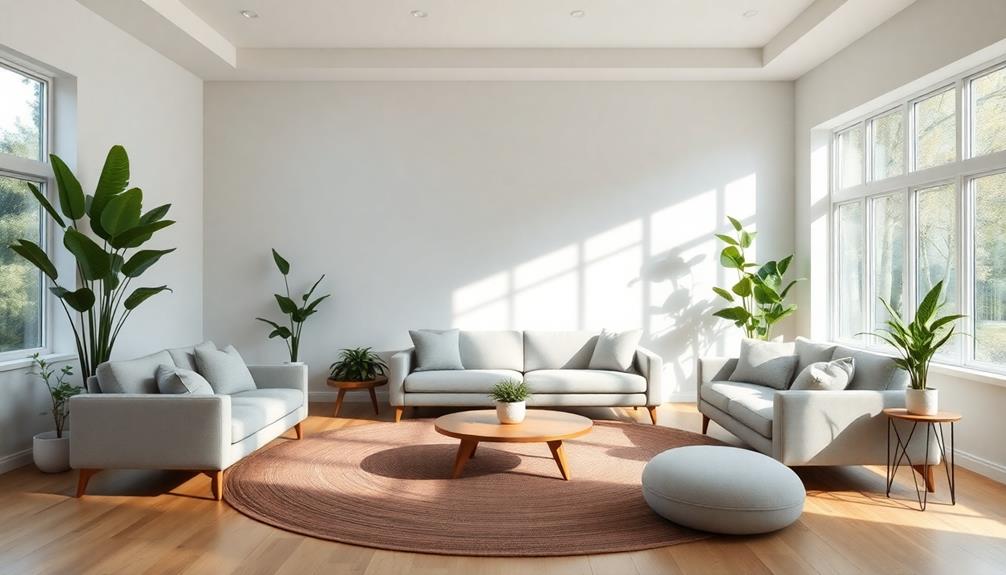
When you plunge into the world of Feng Shui, understanding its core principles is essential for creating a harmonious living space. The flow of energy, or Chi, is central to Feng Shui. You want your home to facilitate this energy's movement, so consider how furniture placement impacts this flow. Blockages can lead to stagnant energy, diminishing the positive energy in your environment.
Incorporating natural materials like wood and stone, as seen in Balinese design elements, can enhance this flow and promote a sense of tranquility.
Balancing Yin and Yang energies is significant, so pay attention to the colors and materials you choose. Warm colors can stimulate energy, while cool tones promote relaxation, making thoughtful selection crucial based on each room's purpose.
The five elements—wood, fire, earth, metal, and water—interact cyclically, promoting balance when arranged harmoniously. However, improper arrangements can create friction.
Decluttering is another key principle of Feng Shui. A tidy space enhances energy movement and clears stagnant sources, leading to a more inviting atmosphere.
Importance of Furniture Placement

When you think about furniture placement, consider how it impacts energy flow and your comfort.
The right arrangement not only enhances functionality but also creates a harmonious atmosphere where movement feels natural.
Incorporating elements of Indonesian traditional decor can further enrich the space, adding character and warmth.
Energy Flow Optimization
Furniture placement plays an essential role in maximizing energy flow within your living space. By thoughtfully arranging your furniture, you can enhance the movement of Chi, allowing positive energy to circulate freely. Incorporating culturally significant decor, such as traditional artistry like Indonesian masks, can further enrich the atmosphere of your home.
Here are some key tips to reflect on for achieving a harmonious living space:
- Avoid aligning furniture directly with doors to prevent obstructing movement.
- Position larger pieces, like sofas, against solid walls for stability.
- Choose appropriately sized furniture to avoid cluttering the space.
- Keep pathways clear to promote smooth energy flow.
- Regularly reassess your layout to maintain ideal energy dynamics.
When you strategically place your furniture, you foster a welcoming atmosphere and create a sense of security. Oversized furniture can block essential energy pathways, leading to stagnation.
Comfort and Functionality
Creating a comfortable and functional living space hinges on thoughtful furniture placement that prioritizes both aesthetics and usability. Proper arrangements enhance comfort by encouraging social interaction, making your home feel more inviting. Here's how you can achieve that balance:
| Key Considerations | Benefits |
|---|---|
| Clear Pathways | Guarantees safety and ease of movement, enhancing energy flow. |
| Proportional Sizing | Prevents cramped spaces and maintains a balanced environment. |
| Thoughtful Placement | Promotes social interaction and connection among inhabitants. |
When arranging furniture, make certain to avoid tripping hazards and awkward positioning. This not only facilitates smooth energy flow but also creates an inviting space for guests. Guarantee that furniture doesn't block doorways or windows, allowing natural light and airflow to circulate freely. Regularly assess your layout; adjusting furniture placement can help maintain the overall functionality and comfort of your living area. By prioritizing these elements, you can create a balanced environment that fosters well-being and connection, enhancing the quality of your home life considerably.
Energy Flow in Different Rooms

Achieving a harmonious energy flow in your home involves thoughtful furniture arrangements tailored to each room's purpose.
For instance, incorporating elements of traditional Indonesian style home decor can enhance the natural ambiance and promote relaxation.
Consider these essential tips for optimizing energy flow:
- Create circular seating in the living room to boost conversation and enhance energy flow.
- Position the bed in the bedroom against a solid wall for a sense of security and restful sleep.
- Place the stove in the kitchen so you can see the entrance, promoting control and positive energy during cooking.
- Use a round table in the dining room to encourage inclusivity and maintain stable energy flow.
- Incorporate natural elements like plants and wood materials to ground the atmosphere.
Living Room Layout Strategies

When arranging your living room, prioritize conversation-focused layouts that encourage connection among family and friends.
Incorporating elements from luxury tropical design aesthetics can enhance the overall ambiance, making the space feel more inviting.
Keeping pathways clear is essential, as it allows for smooth movement and maintains a positive energy flow.
Conversation-Focused Arrangements
A well-designed living room layout can transform your space into a hub of conversation and connection. By focusing on Feng Shui principles, you can enhance the energy flow and create a harmonious space for family and friends.
Incorporating elements of Indonesian wedding decor can also inspire vibrant and inviting arrangements. Here are key strategies for conversation-focused arrangements:
- Arrange sofas and chairs in a circular formation to foster interaction.
- Position seating to face each other, promoting engagement and connection.
- Use area rugs to define conversation groups and enhance intimacy.
- Avoid sharp corners and obstacles to maintain smooth energy flow.
- Incorporate a central focal point, like a coffee table or artwork, to draw attention and encourage conversation.
Pathway Clarity Importance
Clear pathways in your living room layout are crucial for maintaining a positive flow of energy, or Chi. When you prioritize pathway clarity, you facilitate smooth energy flow, allowing Chi to circulate freely and avoiding feelings of congestion or stagnation. Incorporating unique decor, such as a Face Indonesian Decor Mask, can also enhance the aesthetics of your space while promoting cultural appreciation.
If your furniture layout obstructs walkways, it can lead to frustration and disrupt the harmonious environment you desire. To create an inviting atmosphere, make certain that furniture pieces are arranged to promote easy movement. Strategically placing larger items, like sofas and chairs, away from direct pathways reduces distractions and fosters a sense of security and comfort.
This arrangement not only enhances functionality but also encourages interaction among occupants, which is crucial for building connections. Regularly evaluating and rearranging your furniture helps maintain clear pathways, preventing clutter from accumulating. By doing so, you enhance the overall well-being of your living space and promote positive energy.
Bedroom Arrangement Tips
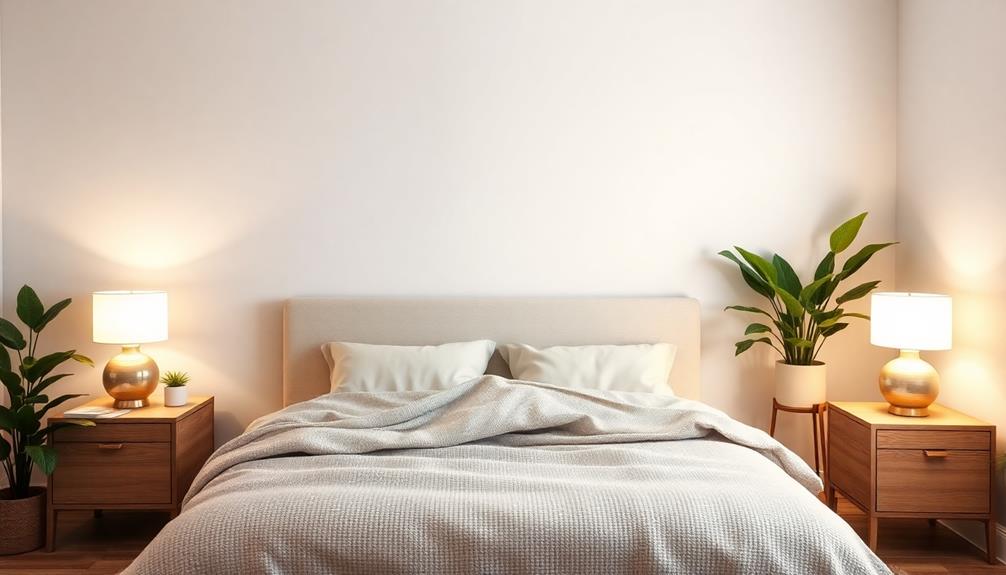
Creating a harmonious bedroom environment starts with the strategic placement of your bed. Position your bed in a commanding location, ideally against a solid wall and not directly facing the door. This arrangement enhances your feelings of security and control while you sleep.
In traditional Indonesian housing, for example, the layout often reflects spiritual elements and cultural symbolism that contribute to a sense of peace within the home, emphasizing the significance of a well-considered space for rest and rejuvenation traditional Indonesian housing.
To guarantee good feng shui, keep the space under your bed clutter-free to promote positive energy flow.
Here are some tips to optimize your bedroom arrangement:
- Choose soothing colors: Soft hues create a calming atmosphere for relaxation.
- Avoid mirrors facing the bed: They can disrupt sleep by reflecting energy and causing restlessness.
- Incorporate natural elements: Adding plants boosts vitality and well-being.
- Guarantee proper bed placement: A solid wall gives you a sense of support and stability.
- Declutter regularly: A tidy space invites peace and tranquility.
Kitchen Feng Shui Essentials

After setting up a restful bedroom, the kitchen deserves equal attention for fostering positive energy. In Feng Shui, the layout of your kitchen greatly impacts your home's overall energy flow.
Start by positioning your stove in a command position, ideally facing the entrance. This arrangement enhances your control and awareness while cooking and avoids direct confrontation with the sink, maintaining elemental harmony. For a more luxurious touch, consider integrating elements of luxury tropical designs that incorporate natural materials and vibrant colors.
Next, focus on the work triangle: the stove, sink, and refrigerator. Keeping this area balanced and unobstructed promotes efficient energy flow, making meal preparation smoother.
Verify that your dining table is centrally located and doesn't block access points, creating a welcoming environment for family gatherings.
To enhance tranquility, use natural materials and colors in your kitchen. Incorporate wooden cabinets and earth-toned accents to create a grounding atmosphere.
Regularly declutter countertops and storage areas to prevent stagnant energy. By eliminating clutter, you'll create a more inviting and functional cooking space that encourages creativity.
With these Feng Shui essentials, you'll transform your kitchen into a hub of positive energy and harmony.
Common Feng Shui Mistakes

When it comes to Feng Shui, many people unknowingly make common mistakes that can hinder the flow of positive energy in their spaces. Here are five key pitfalls to avoid:
- Overcrowding spaces with furniture creates clutter and obstructs energy flow, much like how excessive decor can detract from the beauty of Indonesian decor masks.
- Neglecting natural light leads to dark, uncomfortable environments that trap negative energy.
- Misaligning furniture with doorways blocks the welcoming energy that enters your home.
- Ignoring color choices can negatively impact your mood and the overall atmosphere.
- Failing to declutter results in stagnant energy, making your space feel chaotic.
To create a harmonious environment, focus on optimizing your furniture layout. Verify that your spaces aren't overcrowded, allowing for smooth movement and energy flow.
Pay attention to natural light; let it in to invigorate the room. Align your furniture thoughtfully with doorways and consider how colors affect your feelings and energy levels.
Regular decluttering is essential to maintaining a balanced space, as it fosters a sense of tranquility and openness.
Frequently Asked Questions
How to Arrange Furniture in Feng Shui?
To arrange furniture in Feng Shui, position larger pieces against solid walls for stability, create circular seating arrangements for connection, keep pathways clear for smooth movement, and place beds and desks facing the entrance for control.
How Do I Find the Best Furniture Layout?
To find the best furniture layout, sketch your floor plan, guarantee clear pathways, position larger pieces against walls, avoid blocking doorways, balance visual weight, and use area rugs to define conversation zones effectively.
What Is the Best Layout for Feng Shui?
When it comes to Feng Shui, you'll want to create a space that flows smoothly. Arrange furniture to encourage conversation, position your bed for security, and incorporate natural elements for a harmonious, inviting atmosphere.
How Do You Arrange Furniture for Positive Energy?
To arrange furniture for positive energy, place sofas and chairs in circular or U-shaped layouts, avoid blocking doorways, maintain clear pathways, position key pieces to face entrances, and incorporate natural elements like plants for liveliness.
Conclusion
Just like a river flows freely through a forest, your home should allow energy to move smoothly. When you embrace the principles of feng shui, you're not just arranging furniture; you're crafting a harmonious environment that nurtures your spirit. Avoid the rocks that block your path—common mistakes in placement can disrupt the flow. By thoughtfully considering each space, you're creating a sanctuary where energy thrives, much like a garden blossoming under the sun.
- About the Author
- Latest Posts
Introducing Ron, the home decor aficionado at ByRetreat, whose passion for creating beautiful and inviting spaces is at the heart of his work. With his deep knowledge of home decor and his innate sense of style, Ron brings a wealth of expertise and a keen eye for detail to the ByRetreat team.
Ron’s love for home decor goes beyond aesthetics; he understands that our surroundings play a significant role in our overall well-being and productivity. With this in mind, Ron is dedicated to transforming remote workspaces into havens of comfort, functionality, and beauty.
Southeast Asia Decor
Ultimate Guide to Harmonious Furniture Placement
Perfecting your furniture placement can elevate your space dramatically; discover essential tips that will transform your home into a stylish retreat.

Mastering harmonious furniture placement transforms your space into a sanctuary of comfort and style. Start by measuring your room and furniture accurately, ensuring you maintain clear pathways for movement. Create functional zones for activities, like conversation or dining, and aim for 18-30 inches of space between furniture pieces. Balance your layout with aesthetics, placing matching items intentionally for symmetry. Don't forget storage solutions to keep your space organized and clutter-free. Incorporate principles of Feng Shui to promote a positive energy flow throughout your home. Curious about more tips to elevate your design? There's plenty more to uncover!
Key Takeaways
- Measure room dimensions accurately and maintain clear pathways of at least three feet for optimal traffic flow.
- Establish functional zones using area rugs to create distinct spaces for conversation, dining, and media.
- Position primary furniture facing focal points while ensuring 18-30 inches of space between pieces for comfort.
- Incorporate multifunctional furniture and vertical storage solutions to reduce clutter and enhance space efficiency.
- Balance aesthetics and functionality by using a mix of textures, colors, and symmetrical arrangements for a harmonious design.
Challenges in Furniture Arrangement
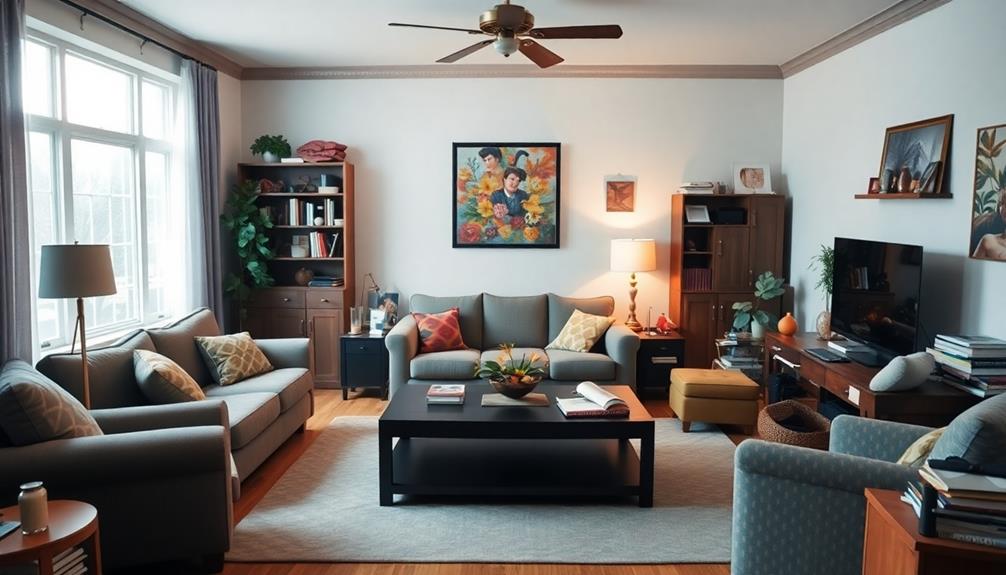
When it comes to arranging furniture, you often face a variety of challenges that can complicate your design plans. Oddly shaped spaces, particularly those created by home additions, can hinder effective use of the area, making furniture arrangement tricky. Prioritizing aesthetics over functionality may lead to obstructed pathways, disrupting the flow of movement and creating clutter.
To create a more balanced atmosphere, consider integrating natural materials and earth tones, which are hallmarks of Balinese design characteristics.
The placement of windows adds another layer of complexity, limiting your options. You'll need to find creative solutions that maintain both light and functionality while ensuring clear pathways. Rooms with multiple entry and exit points require careful attention to accessibility; you want to facilitate ease of movement without sacrificing visual appeal.
Additionally, large or narrow rooms present unique challenges. In these cases, it's crucial to enhance traffic flow and functionality without overwhelming the space. You must find a balance that allows for comfortable navigation while showcasing your design style.
Planning Your Layout

To plan your layout effectively, start by measuring your space and making a scaled drawing or using digital tools.
Incorporating elements like Indonesian Decorative Pillows can add vibrant colors and patterns, enhancing the overall aesthetic of your living area.
Visualizing how furniture flows within the room helps you establish functional zones for different activities.
This thoughtful approach guarantees your space is both accessible and harmonious.
Space Measurement Techniques
Measuring your space accurately is essential for planning an effective furniture layout. Start by measuring the length and width of each wall in your room, including windows and doors. This creates an accurate blueprint for your layout. Use graph paper or digital tools like Floorplanner to draft a scaled version, allowing you to experiment with arrangements easily.
Next, measure the dimensions of your furniture pieces to guarantee they fit comfortably within designated spaces. Remember to account for accessibility and comfort by maintaining a minimum of three feet of width for main walkways and 18-30 inches between furniture pieces.
To help you visualize your space and its functionality, consider the following table:
| Measurement Aspect | Recommended Size |
|---|---|
| Main Walkways | 3 feet minimum |
| Space Between Furniture | 18-30 inches |
| Room Dimensions (Length) | Measure each wall |
| Room Dimensions (Width) | Measure each wall |
| Furniture Dimensions | Measure all pieces |
Visualizing Furniture Flow
Visualizing furniture flow is essential for creating a functional and inviting space. By carefully planning your layout, you can guarantee a harmonious living space that promotes ease of movement and comfort.
Incorporating elements from traditional Indonesian style home decor can enhance the warmth and aesthetic appeal of your design. Here are some furniture placement tips to help you visualize the flow:
- Measure Your Room: Start by measuring your room's dimensions, including walls, windows, and doors. This will provide an accurate representation for effective planning.
- Use Design Tools: Utilize graph paper or digital tools like Floorplanner to create a scaled layout, allowing you to experiment with different arrangements.
- Map Traffic Flow: Draw paths of movement within the room, guaranteeing main walkways are at least three feet wide. This promotes smooth traffic flow and ample space for movement.
- Consider Focal Points: Place primary furniture pieces facing focal points, like a comfortable chair near a fireplace or television, maintaining 18-30 inches of spacing to create negative space.
Establishing Functional Zones
Creating distinct functional zones is a key aspect of planning your layout, allowing you to maximize the usability of your space. By designing areas for conversation, media, and dining, you guarantee each zone enhances overall functionality.
Utilizing area rugs can visually unify furniture within a zone, promoting a cohesive layout. This helps define spaces while making them aesthetically pleasing. Here's a quick reference table to guide your design:
| Functional Zone | Key Considerations |
|---|---|
| Conversation Area | 18-30 inches between pieces |
| Media Zone | 10 feet from TV for viewing |
| Dining Zone | Guarantee ample space for movement |
Maintain a minimum of three feet in width for main walkways to facilitate smooth traffic flow. Consider the scale and size of your furniture relative to room dimensions; this guarantees each area feels balanced and doesn't become overcrowded. Proper furniture placement is crucial in creating functional zones that work harmoniously, allowing your space to be both practical and inviting.
Functional Zones and Flow

To create a harmonious space, you need to define distinct activity areas that support how you use the room.
Incorporating elements from traditional Indonesian housing can inspire unique furniture arrangements that reflect cultural significance.
By enhancing movement paths, you guarantee everyone can navigate freely without obstruction.
This thoughtful arrangement not only boosts functionality but also elevates the overall flow of your home.
Defining Activity Areas
In any well-designed room, defining activity areas is essential for enhancing usability and comfort. By creating distinct functional zones, like conversation areas and media zones, you can guarantee that each space serves its purpose effectively.
For instance, incorporating elements from luxury tropical design aesthetics can elevate your living space while maintaining functionality. Here are some tips to help you achieve this:
- Establish Conversation Zones: Arrange seating to encourage interaction, keeping 18-30 inches between pieces for comfortable spacing.
- Use Area Rugs: These can visually unify your furniture within specific zones, reinforcing a cohesive design.
- Maintain Traffic Flow: Confirm main walkways are at least three feet wide to promote accessible movement and ease of navigation.
- Plan Movement Paths: Before arranging your furniture, draw out paths of travel. This helps visualize how functional zones connect, guaranteeing a smooth traffic flow throughout the room.
Enhancing Movement Paths
Movement paths play an essential role in the overall functionality of a space, ensuring that each area flows seamlessly into the next. To enhance movement paths, start by ensuring main walkways are at least three feet wide, allowing for comfortable movement and accessibility.
Incorporating elements of tropical-themed luxury design can also elevate the aesthetic while maintaining functionality. Aim for 18-30 inches of space between furniture pieces to prevent overcrowding and promote easy navigation.
When arranging your furniture, position primary seating about ten feet from the TV for ideal viewing and maintain clear pathways around it. This won't only keep traffic flow uninterrupted but also create distinct functional zones within your room.
Use area rugs to visually unify your furniture arrangements, helping to define these zones while enhancing usability.
To visualize movement, draw pathways on a floor plan before you commit to furniture placement. This will help you identify any potential blockages in traffic flow and allow adjustments for a more harmonious layout.
Aesthetic Enhancements

A well-thought-out placement of furniture and decor can dramatically elevate the aesthetic appeal of your space. Incorporating unique elements like traditional artistry through Indonesian decor masks can enhance your interior while reflecting cultural richness.
By focusing on key elements, you create a harmonious environment that invites relaxation and enjoyment. Here are some aesthetic enhancements you can incorporate:
- Rug Placement: Extend dining room rugs 36 inches past the table edges for comfort, and guarantee bedroom rugs extend at least 18 inches past the bed frame for a cohesive look.
- Artwork: Center artwork at eye level, about 57 inches from the floor, and maintain a width of 2/3 of the furniture piece beneath it to establish an enchanting focal point.
- Lighting Variety: Use a mix of overhead, task, and ambient lighting. Hang dining room fixtures 30-34 inches above the table for ideal illumination, creating an inviting atmosphere.
- Accent Colors: Introduce cushions and throws to add accent colors that complement your color scheme, while keeping 2-3 inches of negative space between art pieces for a sense of order.
Storage and Decluttering
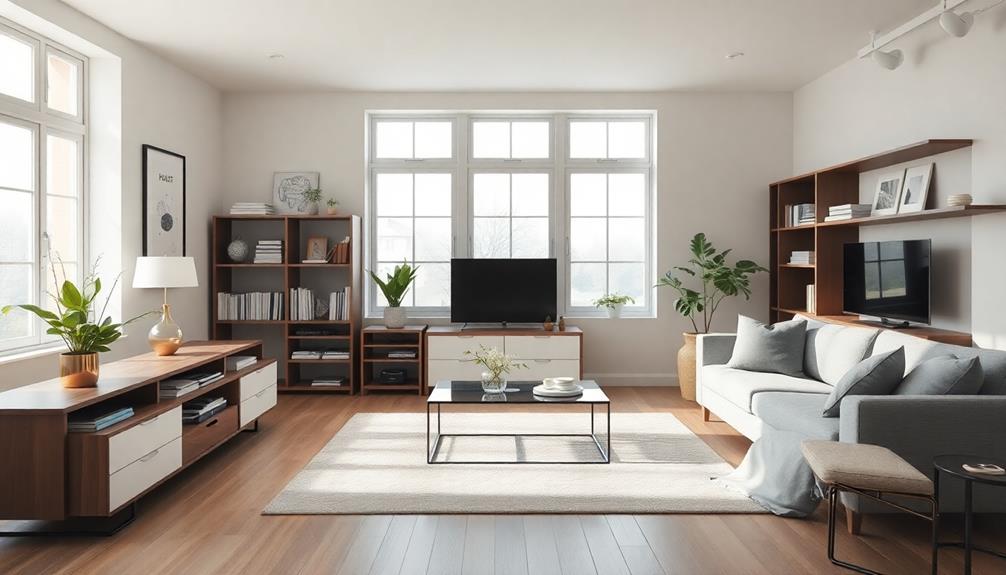
Creating a visually appealing space goes hand in hand with effective storage solutions. To achieve this balance, prioritize multifunctional furniture, like ottomans with storage or coffee tables with drawers. These pieces not only reduce clutter but also maximize space efficiency.
Utilizing vertical storage solutions, such as wall-mounted shelves and over-the-door organizers, keeps items off the floor and fosters an open environment. Regularly reassess your belongings and adopt a decluttering system, like the "one in, one out" rule, to maintain an organized space.
Organizing items by category in designated storage spaces, like baskets or bins, enhances functionality and streamlines the decluttering process. Additionally, consider incorporating built-in storage options, such as under-bed drawers or closet organizers, to optimize storage and guarantee items are easily accessible while promoting visual harmony.
| Storage Solutions | Benefits |
|---|---|
| Multifunctional Furniture | Reduces clutter |
| Vertical Storage | Creates open environment |
| Decluttering System | Maintains organized space |
| Built-in Storage | Optimizes storage |
Principles of Feng Shui

When arranging your furniture, understanding the principles of Feng Shui can greatly enhance the energy flow in your space. By applying these principles, you can create a balanced space that fosters a cozy atmosphere and promotes harmonious living.
Here are some key elements to bear in mind:
1. Clutter Avoidance: Keep your space tidy. Clutter disrupts energy flow, so regularly assess your belongings to maintain a clear environment.
Think about using Indonesian wedding decor ideas that promote minimalism and elegance in your living space.
2. Optimal Placement: Position your furniture to allow for clear pathways. This guarantees smooth circulation of energy (Qi) and creates a welcoming vibe.
3. Yin and Yang Balance: Reflect on the balance between calm (Yin) and vibrant (Yang) energies. A mix of soft textures and lively colors can help achieve tranquility.
4. Elemental Colors: Incorporate colors associated with the five elements: earth, metal, water, wood, and fire.
This not only enhances the aesthetic but also supports the energy needs of your space.
Achieving Balance and Symmetry

Achieving balance and symmetry in your furniture placement can transform a room from chaotic to serene. When you guarantee that visual weight is evenly distributed, you create a harmonious space that feels cohesive and inviting.
To achieve symmetry, position identical pieces, like sofas or chairs, on opposite sides of a central focal point. This arrangement fosters order and stability, making your space more visually appealing.
Incorporating elements inspired by modern tropical aesthetics in Bali can further enhance the natural flow of your space. Don't forget the accessories! Using matching items, like lamps or artwork, on either side of your focal point enhances the symmetrical layout and adds to the overall aesthetic.
While symmetrical arrangements provide a sense of calm, you can also experiment with asymmetrical arrangements for a dynamic atmosphere. Just remember to maintain balance by strategically placing contrasting elements throughout the room.
Properly balancing larger furniture pieces, such as spreading heavier items across different areas, encourages movement and interaction. This thoughtful placement helps maintain a visually appealing environment.
Frequently Asked Questions
How Can I Incorporate Plants Into My Furniture Arrangement?
You can easily incorporate plants into your furniture arrangement by placing them on shelves, beside seating areas, or hanging them near windows. This adds life, color, and improves the overall ambiance of your space.
What Colors Work Best for a Harmonious Space?
What colors make you feel most at ease? Soft neutrals, calming blues, and gentle greens create a harmonious space. They promote relaxation and balance, making your environment inviting and serene. Don't underestimate the power of color!
How Do I Choose the Right Furniture Size for My Room?
To choose the right furniture size for your room, measure your space first. Consider the room's layout, leaving enough walking space, and guarantee the furniture complements your style without overwhelming the area.
What Are Some Tips for Arranging Furniture in Small Spaces?
When arranging furniture in small spaces, focus on multifunctional pieces, keep pathways clear, and utilize vertical storage. Position larger items against walls, and use mirrors to create an illusion of more space.
How Do I Maintain Harmony With Changing Seasons or Trends?
As leaves shift colors, you can refresh your space by swapping textiles and decor that reflect the season. Embrace warm tones in autumn, and lighten up with bright accents during spring—keeping your environment vibrant and harmonious.
Conclusion
Now that you've explored the ins and outs of harmonious furniture placement, you're ready to transform your space like a master chef whipping up a gourmet dish. Remember to take into account flow, functionality, and aesthetics as you arrange your furniture. Embrace balance and declutter to create a serene environment that feels just right. With these tips, your home will not only look good but also feel like a warm hug, inviting you to unwind and enjoy every moment.
- About the Author
- Latest Posts
Introducing Ron, the home decor aficionado at ByRetreat, whose passion for creating beautiful and inviting spaces is at the heart of his work. With his deep knowledge of home decor and his innate sense of style, Ron brings a wealth of expertise and a keen eye for detail to the ByRetreat team.
Ron’s love for home decor goes beyond aesthetics; he understands that our surroundings play a significant role in our overall well-being and productivity. With this in mind, Ron is dedicated to transforming remote workspaces into havens of comfort, functionality, and beauty.
-

 Retreat3 weeks ago
Retreat3 weeks agoIncorporating Biophilic Design in Your Retreat Center
-

 Retreat4 weeks ago
Retreat4 weeks agoDesigning a Retreat Center Kitchen: From Layout to Equipment
-

 Retreat4 weeks ago
Retreat4 weeks agoDIY Rustic Decor Ideas for a Cozy Retreat Atmosphere
-

 Southeast Asia Decor3 weeks ago
Southeast Asia Decor3 weeks agoUltimate Guide to Harmonious Furniture Placement
-

 Retreat2 weeks ago
Retreat2 weeks agoHow to Design and Build a Sweat Lodge for Your Retreat Center
-

 Southeast Asia Decor3 weeks ago
Southeast Asia Decor3 weeks agoHarmonizing Spaces: The Art of Feng Shui Design
-

 Retreat4 weeks ago
Retreat4 weeks agoThe Impact of Lighting on the Retreat Experience
-

 Southeast Asia Decor4 weeks ago
Southeast Asia Decor4 weeks agoFeng Shui Color Schemes Vs Traditional Indonesian Design




























